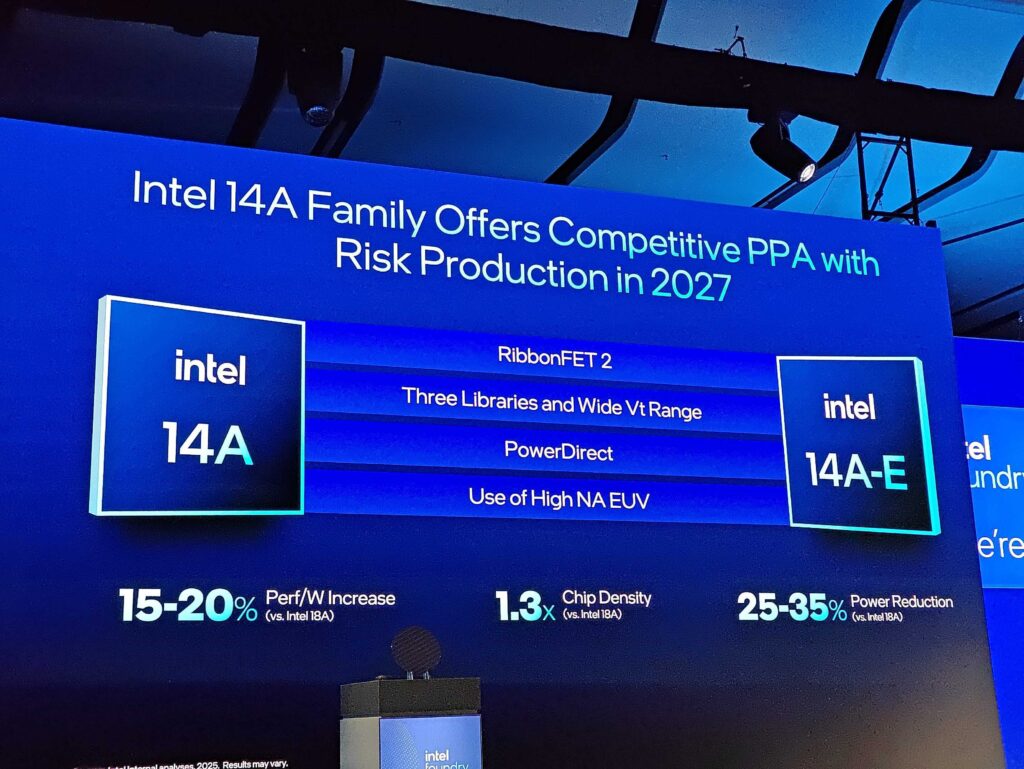As Intel gears up to produce chips using its 18A technology, the company is also introducing a preview of its forthcoming 14A chip node. This new node will incorporate an innovative “turbo cell” technology that aims to enhance the speeds of both CPUs and GPUs.
Originally mentioned a year ago, Intel’s 14A process is expected to increase transistor density on silicon, leading to improved CPU capabilities. On Tuesday, Intel announced that the 14A process will deliver a performance-per-watt enhancement of 15% to 20% compared to the 18A process.

(Credit: PCMag/Michael Kan)
The upcoming 14A process will introduce the new “turbo cell” technology, which Intel claims will further elevate chip performance, particularly for CPU maximum frequencies and GPU critical paths.
According to Intel, “Turbo Cells enable designers to balance a mix of high-performance and power-efficient cells within design blocks, providing a customized trade-off between power, performance, and size for target applications,” as first reported by PCWorld.

(Credit: PCMag/Michael Kan)
Intel outlined details about the 14A process during a foundry event in San Jose, as it aims to compete with TSMC, the main chip manufacturer for AMD, Apple, and Nvidia. The 18A process represents Intel’s most ambitious effort to establish itself as a leading semiconductor manufacturer, following a $90 billion investment over four years to build its foundry business.

(Credit: PCMag/Michael Kan)
Get Our Best Stories!
Your Daily Dose of Our Top Tech News
By clicking Sign Me Up, you confirm you are 16+ and agree to our Terms of Use and Privacy Policy.
Thanks for signing up!
Your subscription is confirmed. Watch your inbox for updates!
Aside from the 18A process, Intel reports that it is already in talks with clients regarding the 14A process. This will include offering a Process Design Kit, or blueprints, to assist clients in creating chip designs tailored to this specific node. “Multiple clients have expressed interest in developing test chips” using the 14A technology, according to Intel.
At Tuesday’s event, Kevin O’Buckley, Intel’s Senior VP for foundry services, emphasized that Intel aims to transform into an “AI services company” at a time when demand for AI chips is surging. He presented a 3D visualization of what seemed to be an enterprise-grade GPU similar to Nvidia, featuring high-speed memory. Company executives highlighted that Intel has been attentive to client feedback to ensure that its chip technology can follow a “predictable two-year cycle,” making it easier for clients to plan ahead.
Recommended by Our Editors
Intel’s roadmap indicates that the 14A manufacturing process is set to launch in 2027. This will include a version called “14A-E,” which will incorporate several additional “feature extensions.” In addition to the turbo cell technology, 14A chips will utilize Intel’s next-generation “RibbonFET” and backside power delivery system to enhance overall performance.

(Credit: PCMag/Michael Kan)
In the interim, Intel is set to use its 18A chip node to manufacture semiconductors for both third-party clients as well as its own applications. This includes the forthcoming “Panther Lake” CPUs aimed at laptops, which are expected to be released in the latter half of this year.
The company is also working on another node named 18A-P, anticipated to roll out next year. Intel states this chip has been “engineered to offer improved performance for a wider range of foundry customers,” implying that it can support chips beyond standard CPU applications.
About Michael Kan
Senior Reporter



